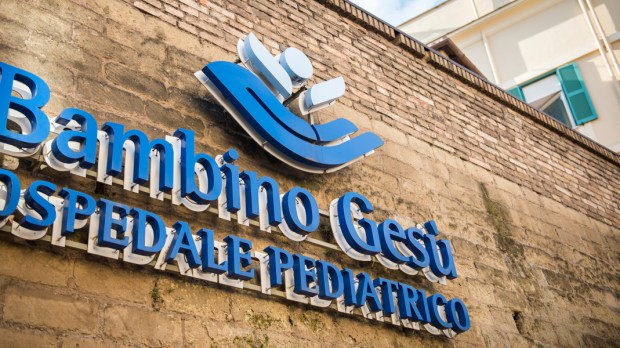Bambino Gesù Children’s Hospital is celebrating 100 years under the direct purview of the Holy See. The hospital opened as the first medical facility in Italy to cater to children’s needs, but as “The Pope’s Hospital” it has grown to become the most important pediatric healthcare center on an international level.
The beloved Catholic children’s hospital of Rome was founded in 1869 by the generous Salviati family. Bambino Gesù’s website credits Duchess Arabella Fitz James Salviati with the idea, although she found strong support in her husband, Duke Scipione, and her children, who reportedly gave Arabella their “piggy bank” – this was before they were shaped like pigs – to help fund the initial construction.
In March 1869, Bambino Gesù welcomed four little girls as its first patients, who were tended to by the Daughters of Charity of St. Vincent de Paul, who managed the hospital. By 1887, however, the hospital had to move locations due to a municipal project to protect Rome from flooding. Duchess Salviati was entrusted with a portion of the convent of Sant’Onofrio, a 15th-century building that required two years to renovate into a hospital. At the new location, staff worked ceaselessly and by 1907, Bambino Gesù had received 1,000 patients.
Duchess Arabella passed away in 1903 and the family kept the hospital operating for another four years before it was finally donated to Pope Pius XI. This began a period of expansion that saw the rise of additional buildings that were dedicated to advancing medical research, especially of “children’s diseases.” Much of the funding for these expansions came from other nations, especially from the United States.
This path of development, however, was stymied when World War II began. During the war, the hospital fell under the control of Nazi-fascist troops, but it continued to operate in service primarily to children. Some at the hospital also worked to hide Jews as doctors, nurses, and orderlies, with Jewish children mixed into the child-patient population to blend in with other patients.
After the war, more fundraising was needed to restart its operation fully, and it was found in Pope Pius XII and the contributions of the US episcopate. Over the next two decades, new buildings were erected and an emphasis was placed on professional training, leading to the 1960 opening of the School for Childhood Supervision Workers, which is today known as the Pier Giorgio Frassati School of Health Professions.
Bambino Gesù was integrated into the national healthcare system of Italy in 1978 and by 1985 it was recognized as a scientific hospital and treatment institute. It became a place of international collaboration that led cooperation missions in developing countries. In 2006 the hospital obtained its first accreditation from the JCI (Joint Commission International), and just three years later the Bambino Gesù became a university hospital.
Most recently, Bambino Gesù announced that they will be opening a new headquarters location in the Lazio Region that will be the largest children’s hospital in Italy in terms of beds. Click here to read more.



